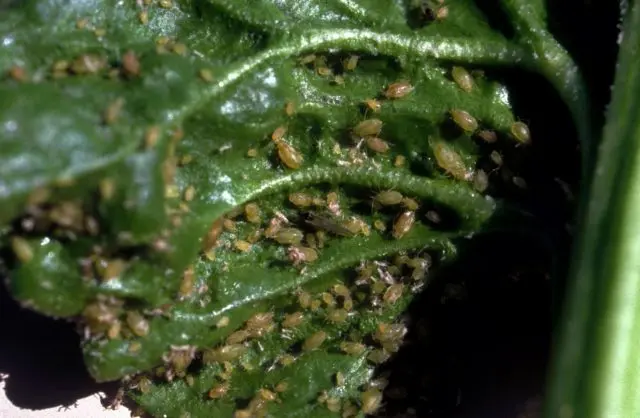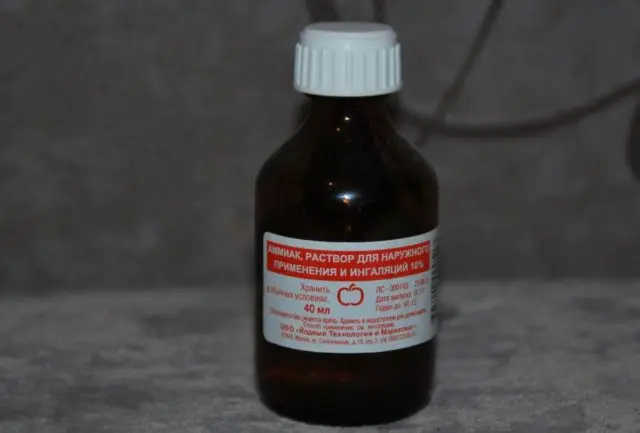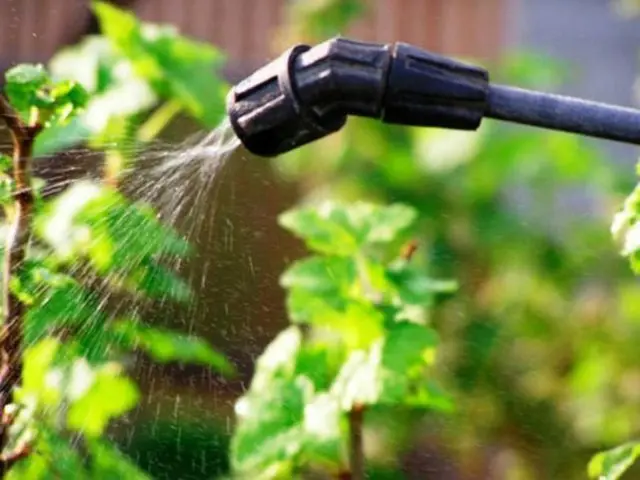Contents
Spring is the period of the main growth of berry bushes. Plants intensively gain green mass, the subsequent fruiting depends on the degree of growth. But at this time there is a spread of colonies of parasitic pests. Ammonia from aphids on currants eliminates pests and nourishes the shrub with microelements necessary for vegetation.

Does ammonia help against aphids on currants
Aphid is an insect that parasitizes on fruit trees, vegetable crops, but the main accumulation is noted on young shoots and currant leaves. The presence of the pest is determined by the state of the leaves, they curl, dark convex spots appear on the surface.
On blackcurrant, shoot aphids of a light green color are found. On white, yellow and red gall aphid parasitizes, a microscopic insect, so it is almost impossible to see it. It is often mistakenly believed that the plant is affected by an infection, and an incorrect definition of the cause leads to an aggravation of the condition, because the methods of combating the disease and parasites are different.
Pests feed on the juice of young shoots and leaves, the plant weakens, loses productivity.
Currant dies without timely action.
The chemical industry offers a wide range of insecticides for pest control. They are used in critical situations. Substances kill all living organisms, including bees pollinating shrubs. The use of pesticides during flowering and fruit set is not recommended. Therefore, ammonia from aphids on currants is the best option to fix the problem:
- ammonia kills the pest;
- the product is easily accessible, it is sold in any pharmacy;
- economical in terms of cost;
- does not have a toxic effect on humans.
Ammonia is safe for bees, contains nitrogen necessary for the growth of currants. The processing of the plant is carried out at certain time intervals, the last one, when berries are formed on the currant. The use of chemicals during the fruiting period is highly undesirable, ammonia is one of the acceptable options for eliminating insects.
How ammonia works against aphids on currants
The substance acting on aphids in the composition of ammonia is ammonia, which acts as an insecticide. Pharmacies sell a 10% solution, this concentration is enough to get rid of the pest. Ammonia is used in the spread of parasitic insects on currants and as a prophylactic.
The action of ammonia on aphids after processing currants occurs quite quickly. The drug settles on the leaves and stems of the currant, is quickly absorbed, the juice from the treated areas causes dysfunction of the digestive tract, ammonia vapors disrupt the respiratory function. Ammonium chloride triggers a mechanism of irreversible actions in the body of an insect:
- a burn occurs in the gastrointestinal tract;
- swelling of the mucous membrane blocks the access of oxygen, the insect cannot breathe;
- convulsions occur;
- the final stage is paralysis;
The duration of action of ammonia is 40 minutes, then the insect dies.

Preparation of the solution
The product is sold in bottles of 40 ml. The volume of the solution is sufficient to process currants throughout the season. A mandatory procedure is the use of ammonia for currants in the spring, before the start of the main growing season. The tool is used for preventive purposes. The components of the solution for feeding currants and preventing the appearance of pests:
- ammonia – ¼ bottle;
- water – 10 l;
- tar liquid soap – 4 tbsp. l.
Currant bushes are sprayed, the rest of the solution is suitable as root dressing not only for currants, but also for all fruit trees and berry bushes on the site. No nitrogen fertilization is required after this.
To combat aphids, make a more concentrated solution. The volume depends on the number of currant bushes, it can be increased or decreased if necessary:
- water – 2,5 l;
- ammonia – 10 ml;
- concentrated soap solution – 1 tbsp. l.
Soap for treating currants from aphids can be used commercially available liquid laundry soap, or you can cook it yourself. To do this, the bar is rubbed on a grater and poured with hot water, left until completely dissolved. The consistency should be thick. It is better to use tar soap with a sharp specific smell that will scare away other insects that parasitize currants. Aphids do not have a chitinous shell, the alkali in the composition of soap is fatal for her.
Methods for processing currants with ammonia
Currant treatment with ammonia is carried out on a calm day in the morning or evening. The time of day was not chosen by chance – this is the period of minimum pest activity. In sunny weather, ammonia evaporates quickly, so spraying is not effective enough.
Equipment for work is chosen taking into account that the sprayer is not small, the sprayer for indoor plants is not suitable. The garden one is equipped with a device that regulates the volume of drops and the flow of the jet, it is used most often. In extreme cases, you can use a watering can, but the expense of funds will be greater.
The main task in the processing of currants is to ensure that ammonia gets to the main place where aphids accumulate. Process the tops of the stems and the lower part of the leaves. After spraying, the problem areas of the plant should be completely wet. Then spray the rest of the crown of the bush. With a strong accumulation of insects, the stem with leaves can be dipped into the solution.
Treatment of currants with ammonia begins to be carried out in early spring, the frequency depends on the degree of damage. They stop using ammonia only after the currant berries begin to turn in the color corresponding to the variety.
Ammonia is an effective insecticidal agent; it is enough to spray twice to rid the shrubs of aphids.

Safety measures
When working with ammonia, safety precautions must be observed. A substance with a pungent odor can cause swelling of the nasopharyngeal mucosa. Possible cough and nasal discharge. This feature of the substance can provoke an unpredictable reaction in people allergic to ammonia. For protection, use a gauze bandage, ideally a respirator.
When spraying, the ammonia solution dissipates in space, contact with eyes and mouth is not excluded. Ammonia will not provoke poisoning, the dosage in solution is safe for humans, but redness and itching around the lips may appear. If it gets into the eyes, ammonia causes redness, burning and tearing. It is recommended to wear safety goggles while working.
Work on the preparation of a working solution from ammonia is carried out in rubber gloves, they are also used during work. Depending on the structure of the epidermis on the hands, ammonia can cause irritation, burns.
Tips from experienced gardeners
The effectiveness of ammonia against aphids is discussed by fans and skeptics alike. As a top dressing, the remedy is used given, the benefits are beyond doubt. According to experienced gardeners, the drug is not inferior to chemicals, you just need to use it correctly.
A few tips to increase the effectiveness of the use of ammonia in the garden:
- The working solution is made only in cold water and immediately used.
- Aphids can fly to neighboring plants, reproduction in insects is asexual, therefore, healthy and affected currant bushes are treated with ammonia.
- If after treatment it rained, the procedure is repeated.
- Constant spraying of an annual plant is not recommended, because salts accumulate in the soil, which inhibits the development of the root system.
- You can not often use ammonia, excess nitrogen will have the opposite effect, the leaves will turn yellow, shedding of ovaries is possible. The plant is treated no more than 1 time in 14 days.
At the first appearance of pests, it is necessary to inspect the site for anthills. Ants “breed” aphids, protect from external enemies. In the process of life, aphids secrete a secret – honeydew, a sweet substance that ants feed on.
Conclusion
Ammonia from aphids on currants has been used by gardeners for a long time and quite successfully. The solution destroys pests by affecting the digestive and respiratory systems. Use the drug for preventive purposes. Due to the high concentration of nitrogen in the composition of the product, it is used to feed shrubs.









